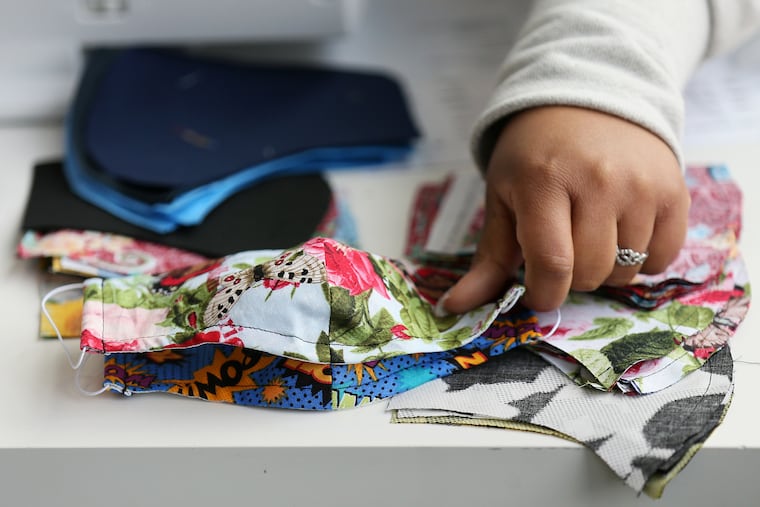How to clean your face mask
But a lot of people still have questions about face masks and preventing the spread of coronavirus. How do you take care of your new covering? How many do you need? How do you properly take it off and put it on? We have answers.

By now, we all know that we should be wearing face masks when going about essential tasks in public as part of the fight against the coronavirus pandemic.
Those types of masks have become a hot topic online during the pandemic, and are often constructed simply of cotton fabric, elastic, and some thread. According to the CDC, cloth masks can help prevent people who have the virus but may not be showing any symptoms from spreading it by containing the respiratory droplets that we all expel when we talk, cough, or sneeze.
Or, as the Pa. Health Department puts it, “my mask protects you, your mask protects me.”
But a lot of people still have questions. Chief among them: How do you take care of your new covering? How many do you need? How do you properly take it off and put it on? Here is what you need to know:
How many masks should you have?
The Pa. Health Department recommends that you wash or discard a mask after every use. With that in mind, having more than one mask available per person would be ideal.
Nicole Jochym, a third-year medical school student at Cooper Medical School at Rowan University working with the Sew Face Masks Philadelphia organization, says that five masks per person would be a good number, but at least two is advisable. That way, you can change your masks as needed and won’t be stuck constantly doing laundry.
“You should have a small set,” Jochym says. “Your set should be determined on your habits, and how you keep up with laundry and care.”
» READ MORE: Use our simple template to make a face mask at home: A step-by-step guide
How often do you need to change them? Darrell Spurlock, director of the Leadership Center for Nursing Education Research at Widener University and a professor in Widener’s doctoral nursing program, says you should treat your masks like you treat your underwear.
“Lacking available data to suggest otherwise, changing out or laundering a cloth mask should follow the same routine as underwear,” he says. “Change them daily and when soiled.”
How do you wash your face mask between uses?
Officially, the Pa. Health Department recommends cleaning your masks using hot water and regular detergent, and then drying them on the hottest setting on your dryer. The CDC echoes that sentiment online, saying that masks should be “routinely washed” and that a “washing machine should suffice in properly washing a face covering.”
“Normal laundering of washable masks made of clothing fabric, including drying the masks on high heat, should be sufficient to remove any appreciable viral inoculation of novel coronavirus given what is known about its survivability on surfaces,” says Spurlock.
Jochym, however, has her doubts about whether simple washing of masks is effective, and is concerned that washing machines and dryers may not get hot enough.
With that in mind, though, here’s what she’s doing, personally: She alternates between boiling her masks in a pot for 10 minutes or soaking them in a bleach solution before washing them on her washer and dryer’s hottest settings. The efficacy of those methods, she says, has not been confirmed, but they may be a good place to start.
» READ MORE: What you need to know about homemade masks
How to put on and take off your mask properly
Before putting your mask on, the Pa. Health Department recommends, you should wash your hands with soap and water or use an alcohol-based hand sanitizer. Once on, the mask should fit snugly around the nose and mouth.
“Avoid touching the mask while using it,” the department says online. “If you do, wash your hands with soap and water or alcohol-based hand rub.”
» FAQ: Your coronavirus questions, answered.
Removing a mask should be done from behind, says the department, and don’t touch the front of the mask. And the CDC says to avoid touching your nose, mouth, and eyes, and wash your hands immediately after removing it.
Jochym recommends storing the used mask in a plastic bag, and not touching it again until it is cleaned.
“When putting it in a pot or washing machine, dump it in from the bag,” she says. “Assume everything is dirty.”
More face mask dos and don’ts
The CDC stresses that you shouldn’t take up the supply of surgical masks and N95 respirators, which should be “reserved for health-care workers and other medical first responders.”
“Do not purchase masks designed for health care professionals,” the Health Department says in a statement.
Likewise, don’t consider a cloth mask to be the end-all-be-all method of reducing the risk of getting COVID-19. According to the department, cloth masks should be used in conjunction with other recommended practices, such as social distancing, handwashing, and staying at home unless absolutely necessary.
“Remember, the purpose of mask-wearing by the masses is to protect the uninfected from those who may be silently carrying and spreading the virus,” Spurlock says. “Not to prevent the uninfected from becoming so.”